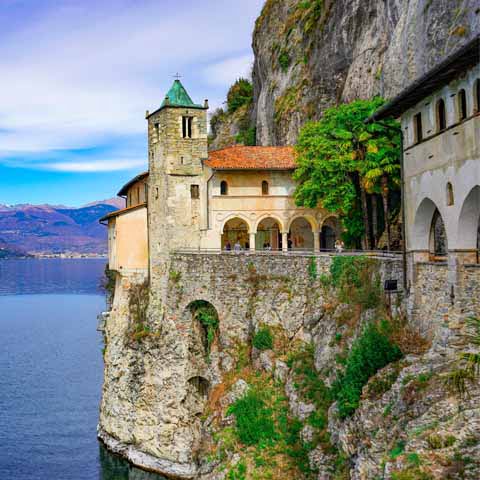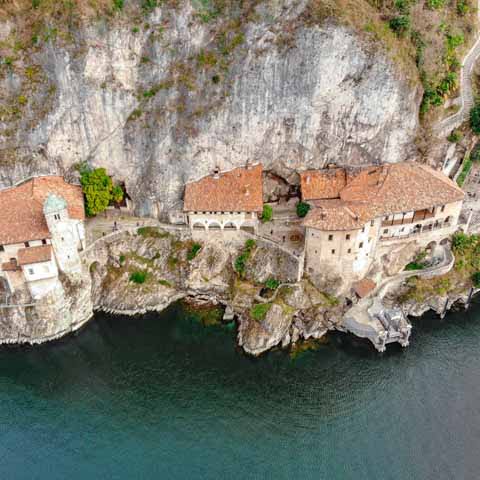Lake Maggiore is a basin area stretching between Northern Italy and Southern Switzerland and is the second largest Italian lake after Lake Garda. It is located close to the alpine circle and occupies a tectonic furrow, which resulted from glacial erosion.
The lake presents its maximum development in Italian territory, where it acts as a borderland between the provinces of Verbano-Cusio-Ossola and Novara (Piedmont) on the western shore, and Varese (Lombardy) on the eastern shore, while its northern stretch belongs to Switzerland (Ticino).
Like most lake areas in Italy, the area of Lake Maggiore has been inhabited since the earliest times and shows important evidence of the passage of various civilizations.
PREHISTORY OF LAKE MAGGIORE
The entire area surrounding Lake Maggiore was inhabited since prehistory. Evidence scattered throughout the territory refers to the Bronze and Iron Ages, and most findings belong to the Golasecca culture. These artifacts were primarily found in the province of Varese but also near the Lagozza, Lake Varese, and Locarnese areas.
It is believed that the first civilizations settled in these areas were the Etruscan, Umbrian, and Gaul populations, among which were the tribes of Insubers.
The Romans arrived in the region towards the third century BC, but only started to impose their power a century later, when they began reclaiming lands, opening roads, and founded the first fortified hamlets, primarily as a defensive measure against the barbaric invasions.
During the Roman Age, Lake Maggiore was called Verbanus, and it soon became one of the most important military and commercial centers in the area. Since those times, the opposite shores engaged in trade relations with one another.
Due to its strategic importance, the lake was soon included in the regions of Augustan Rome, with Milan as its capital.
The Roman Empire focused on building connection roads near the lake area, from the plains towards the Alps, in an attempt to create trade routes and passages with the rest of Europe.
From the third century AD, Christianity began to spread through the area thanks to the work of San Gaudenzio, San Giulio di Orta, San Lorenzo, and San Barnaba.
HISTORY OF LAKE MAGGIORE
Although the area surrounding Lake Maggiore was not involved in major conflicts during the Roman era, the fate of the territory changed following the barbarian invasions, which brought destruction and famine.
From 569, the Lombards established themselves in Northern Italy and also took possession of the lands near Lake Maggiore. This invasion concluded with the abolishment of the Roman municipalities and the establishment of Lombard ducats founded on military order.
However, their dominion did not last long, and in 774, Lake Maggiore and surrounding areas passed under the Frank domination. Charlemagne was oriented towards the papacy and began a policy of territorial division. During his time, the first counties and duchies along both shores of the lake emerged with Angera at the center of one of the counties.
The territorial division also involved a division of powers between clergy and noble families; with the extinction of the Carolingian dynasty though, the whirling feudal reign in Italy saw the victory of Otto I, Duke of Saxony.
Known as the promoter of the Holy Roman Empire, Otto I imposed an imperial feudal system under the direct control of the Emperor that concluded with a complex development of intricate feudal struggles between the religious and secular powers.
These struggles continued when the lords of De Castello, followed by the Barbavara, imposed their dominion in the lake area. However, some parts of Lake Maggiore remained under the influence of the archbishops of Novara, Milan, and Vercelli, who were responsible for exerting temporary ecclesiastical feudalism.
With the rise of the power of the archbishops of Milan, and especially with the rise of the Visconti, Lake Maggiore slowly started to enter into the Visconti area of influence. In fact, the Visconti skillfully knew how to manage the change of powers to their own benefit.
The family soon became the arbiter of the destiny of Milan and Lombardy, extending their power up to Lake Maggiore, which witnessed a period of stability under their rule.
Perhaps the main change the Visconti brought to the region was the communal experience. They granted the villages around the lake with statutes and internal regulations which were recognized and respected both by Visconti and by the other noble families in the region.
With this policy of lordship, the Visconti established a peaceful coexistence in the lake area. The various factions represented either the Visconti or other exponents, such as the Guelph and Ghibelline families. In reality, though, the nobles tended to preserve the privileges acquired while formally maintaining their obedience to the various monarchs of the Holy Roman Empire.
Filippo Maria Visconti was the last in the dynasty to rule over Lake Maggiore, ceding the territory to Vitaliano Borromeo in 1439. As a result of other struggles with Venice and Florence, Filippo Maria Visconti was no longer capable of overseeing the area of Lake Maggiore.
The Borromeo exerted authority over the lake area until the arrival of the Sforza; then in 1535, the entire Verbano area became part of the Habsburgs of Spain, the new rulers of the Duchy of Milan.
During this period, the fiscal regime of the Spaniards took its toll on the region and their mismanagement had a negative impact on the economy of these lands. This, coupled with famine and plague, quickly lowered Lake Maggiore to the poorest conditions.
Despite some slight improvements during the Austrian domination in the eighteenth century, the return of the Savoy and the surrender of the western shore of the lake brought new struggles to the region.
Amidst all these struggles, Napoleonic troops reached the eastern shores of the lake and included them into the new political orders of the French Emperor. At the end of the Napoleonic period, the Congress of Vienna in 1815 restored the previous situation, and the western coast of the Lake returned to the Savoy, while the eastern coast returned to Austrian domination.
Lake Maggiore was directly involved in the Risorgimento Movement during which the troops of Garibaldi opposed the overwhelming Austrian armies, followed by fierce battles in Cannobio and Laveno in May 1859.
Like all surrounding territories, Lake Maggiore joined the Kingdom of Italy in 1860. Despite the slowed progress under the Spanish misgovernment, the situation gradually accelerated after the unification, and the whole area of the lake soon entered into a true commercial, economic, industrial and cultural renewal, following the trends in the rest of Northern Italy.
One of the most important infrastructural works in the region was the construction of the Traforo del Sempione (Simplon Tunnel), which greatly contributed to the development of the western side of the lake.
The two world wars did not leave major scars on the territory. However, during World War II, Lake Maggiore was the site of massacres perpetrated by German troops following the Italian surrender, and the Ossola Mountains were an important center during the final resistance movement.
Currently, Lake Maggiore is administratively divided into the provinces of Novara, Verbano-Cusio-Ossola, and the province of Varese, while the extreme north of the lake stretches into Swiss territory in the canton of Ticino.
Today, Lake Maggiore is one of the most important tourist destinations in Northern Italy and Southern Switzerland. Villages and towns along the banks are mainly involved in the tourism and service sectors, while larger cities in the region have a more industrial economy.
ARCHAEOLOGY IN LAKE MAGGIORE
The entire area of Lake Maggiore has attracted civilizations since the earliest times, and evidence of their passage is scattered throughout the region.
Evidence from the Neolithic Era includes some primitive carvings with a hemispherical shape and a diameter of a few centimeters, which were dug into rocks and boulders. It is believed that they are linked to an ancestral cult, but their function is still unknown.
Nevertheless, these excavations are very common, especially in the Piedmont area of the lake and along most ancient roads.
The area also holds important evidence from the Bronze and Iron Ages. Most of these findings are linked to the Golasecca civilization, which established itself along the western shores of Ticino and throughout the surrounding territory.
Most artifacts from this period consist of funerary objects, as well as ceramics and pottery, and the majority are housed in the Civic Museum of Sesto Calende.
Another important place from an archaeological point of view is the Devil’s Wall in Crodo. This imposing dry stone wall is linked to the sacred rites of ancient civilizations and shows clear evidence of a Celtic tradition.
The Roman remains are also well-represented throughout the territory. In Romagnano Sesia, there is a fine example of a votive column depicting two Roman magistrates, while in Gravellona Toca the remains of a Roman fort can be admired.
Those interested in ancient cultures and traditions can also find multiple artifacts in the numerous archaeological museums in the area.
One of the most important is the Civic Archaeological Museum of Angera, housed in a beautiful fifteenth-century building. The museum features some of the most important artifacts of the territory.
The collections are divided into various rooms dedicated to prehistory, Roman history, and medieval history. Some of the most important attestations belong to the Upper Paleolithic and the Copper Ages.
Findings from a Roman necropolis alongside numerous artifacts from the area of Angera are also exhibited in the museum.
A Tactile Table allows visitors to touch and even try out some of the prehistoric techniques. Furthermore, a colorful installation dedicated to children allows youngsters to engage in numerous didactic and cultural activities.
Besides the museum in Angera, the entire territory of Lake Maggiore is scattered with archaeological and civic museums, as well as open-air archeological sites, both in the towns and in the countryside of the territory.
Travel Guides
The Piedmont Region of Italy
The Cities of Piedmont, Italy







